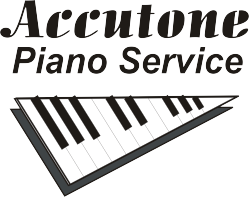Rarely do I have the mis-fortune of advising a piano owner that there’s no more life left in the piano, and that one needs to think of getting another one. But, these are machines that have a definite life span, just as we all do. There are core parts of a piano that must work and be in some kind of order, or the poor pianist will have to improvise and struggle to play it. Especially for beginning students, trying to play a worn-out piano is an exercise only in frustration!
The first part of the piano that is critical is the soundboard. It is constructed to be in a constant state of tension and compression so that it will transmit sound properly. It has, in fact, a warp built into it. We call it “crown”. As the years go by, the crown begins to disappear as the board flattens out. When this happens, you get a very percussive sound, but little sustain. Also, the ribs, which you can see under a grand piano by looking at the bottom of the piano, sometimes come unglued from the board. It’s also possible to have cracks in the soundboard. These are not necessarily a death-knell for the piano, and often are just cosmetic. But the ribs often separate where there are cracks, and this causes buzzing when certain notes are played. Cracks are a sign that the board has been under too much strain, likely due to large swings in humidity.
The next part of the piano is the one you’re familiar with- they keys and the action inside the piano. The keys need to be level, and set at a certain height to make the action function correctly. In course of time, the keys will sag, especially in the middle where they’re played most often. Tiny doughnuts of felt hold up the keys, like a teeter-totter, in the middle. Silverfish and other bugs are fond of eating the felt, so this causes the keys to sag. Inside the action, thousands of wooden parts are used to make the mechanism that hits the strings. Every part of the action is resting upon felt, including the bearings and bushings. When the bearings wear out, parts get loose, and the function of the action is compromised. Even the wood itself becomes brittle after a very long time, and often things break. At a certain point, the wood cannot take the pounding like it used to do.
Then, there are the strings themselves. Obviously if they break, they need replacement. Over many years, the steel wires get brittle. If the piano hasn’t been tuned regularly, adding a lot of extra strain by tuning them causes them to break. If more than one or two break, it may need to have all new wire installed. Then there’s the tuning pins that hold the tension of the wire. The tuning pins are driven into a thick piece of plywood called a pinblock. After many years, the pinblock may dry out. This causes the tuning pins to loosen, sometimes to the point where they will no longer hold the tension of the strings. In that case, the pinblock may need replacement, or some remedy may be applied to make them hold again. The newest technique is to drip very thin SuperGlue into the wood surrounding the pins, which will increase the holding power of the old pinblock.
And, of course, there’s the cabinet. If the poor old piano looks to beat-up to put in your living room, the end is near. You may need to have it refinished.
Now, if this piano belonged to your great Grandmother, the concert pianist, or it’s an heirloom that you can’t part with, old pianos can certainly be rebuilt and refinished. But be aware that nearly all the money you spend may not come back to you when you sell it. The exception is a Steinway, Baldwin, Mason-Hamlin, Chickering, Knabe, or other famous name piano. It is sometimes possible to get a lot of residual value from these pianos. But, for most pianos, refurbishing or rebuilding them is only worth it for the current owner. It’s a judgement call whether it is worth spending money on. Having a qualified technician inspect your piano is a sure way to find out whether you have a gem-in-the-rough, or a disaster that couldn’t wait to happen.
Paul



